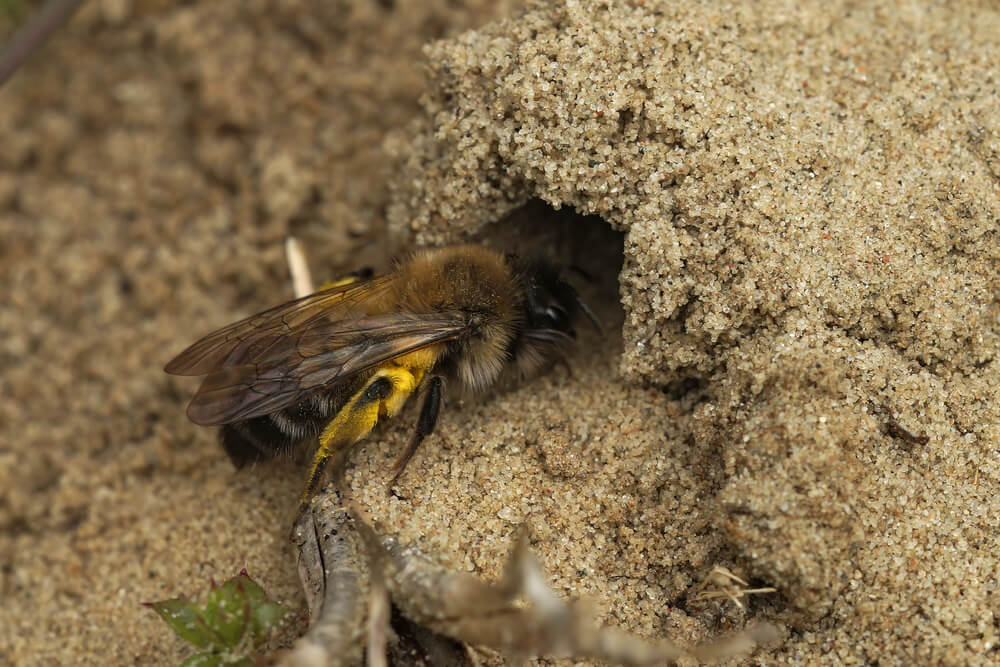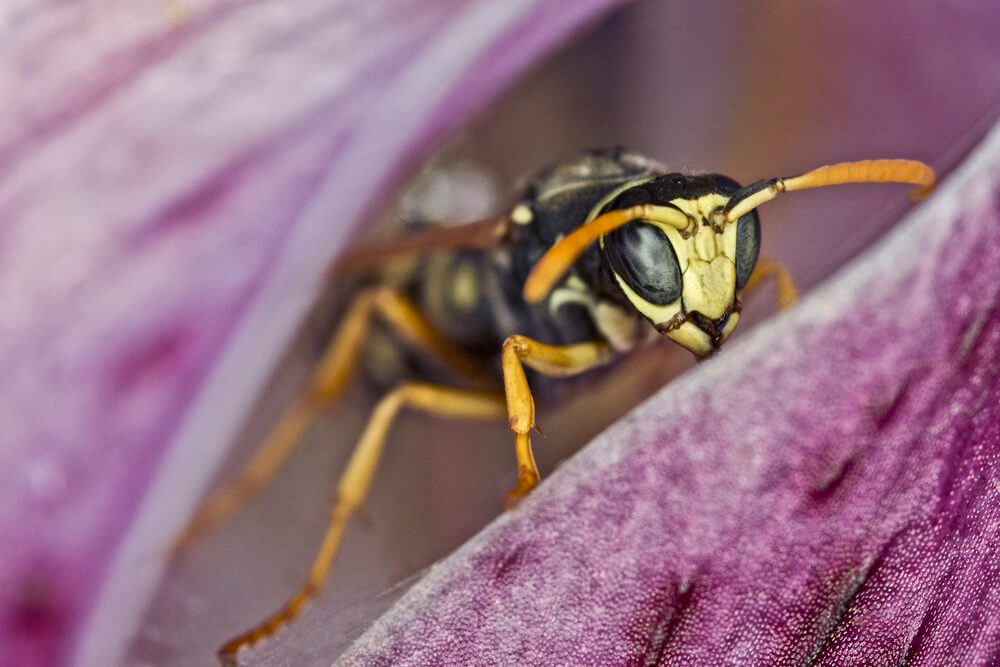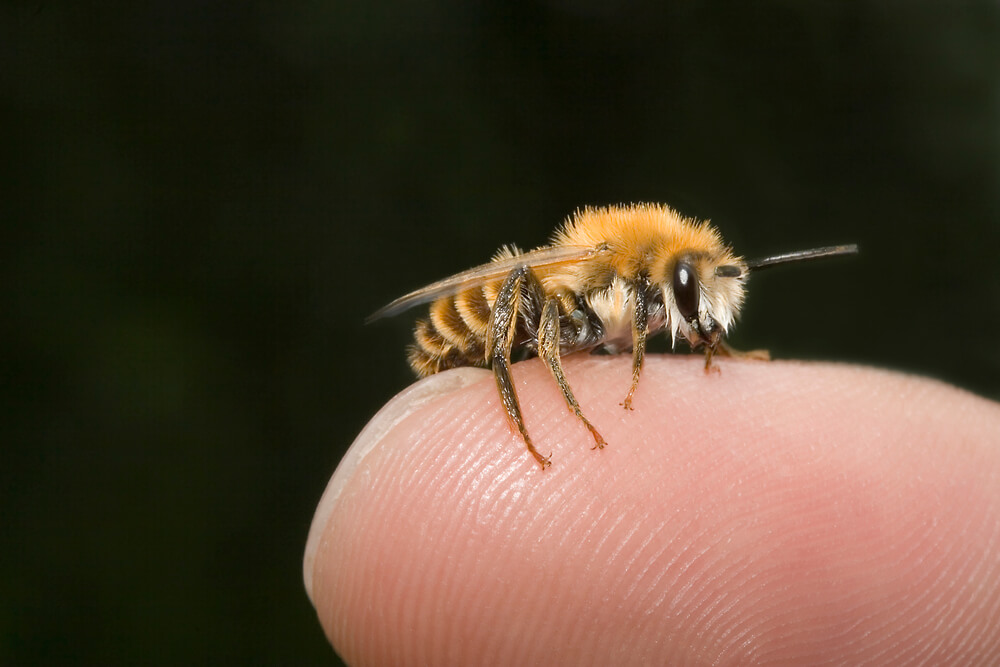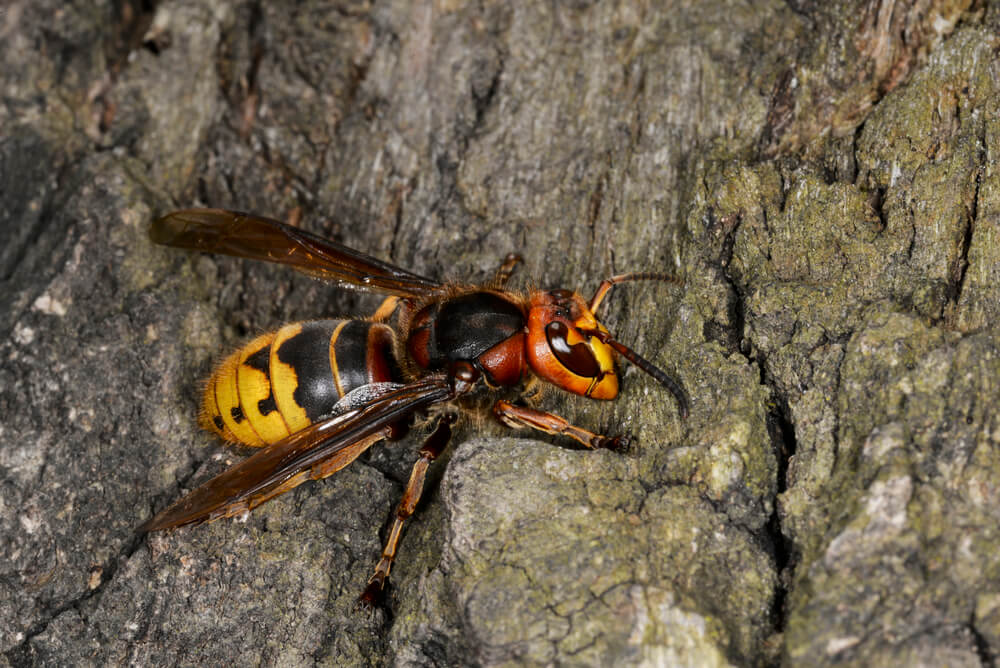Table of Contents:
Are Beehives on the Ground a Problem?
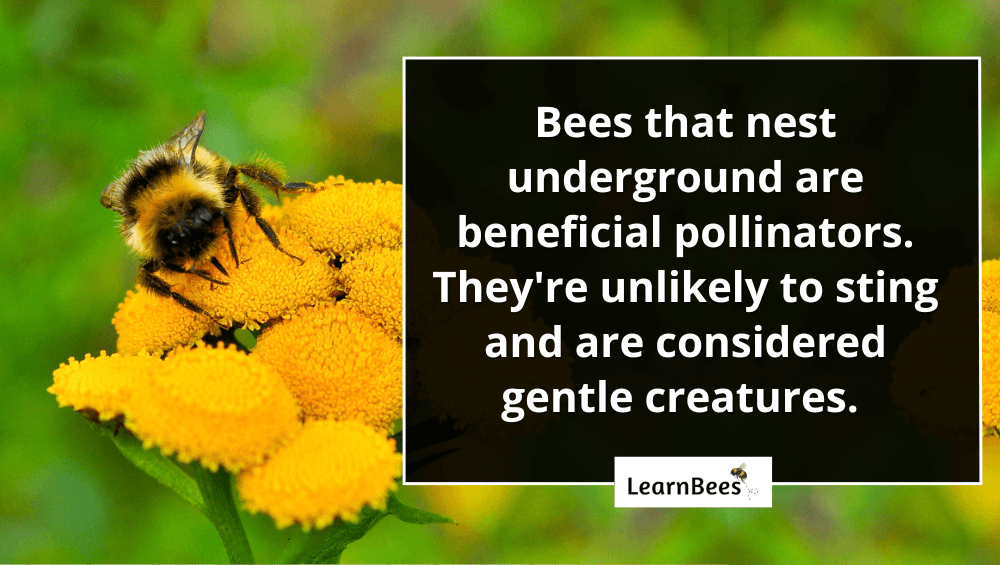
Short answer:
No, beehives on the ground typically aren’t a threat to you, your lawn, or your pets.
In fact, it’s quite the opposite.
Ground bees are considered gentle bees that rarely sting. Most of them will fly away from a threat instead of confronting it.
And more importantly?
Ground bees are a vital part of our ecosystem.
Pollinators, most often bees, are responsible for one in every three bites of food we eat. This includes foods like coffee, apples, blueberries, almonds, and much more.(1)
As such, bees are considered a keystone species. Keystone species are the glue that holds ecosystems together. Without them, the habitat would be drastically different or cease to exist entirely.(2)
Bees support the growth of trees, food crops, and other plants, which provides shelter and food for other creatures.
But make no mistake.
Ground bees are not the same thing as yellow jackets.
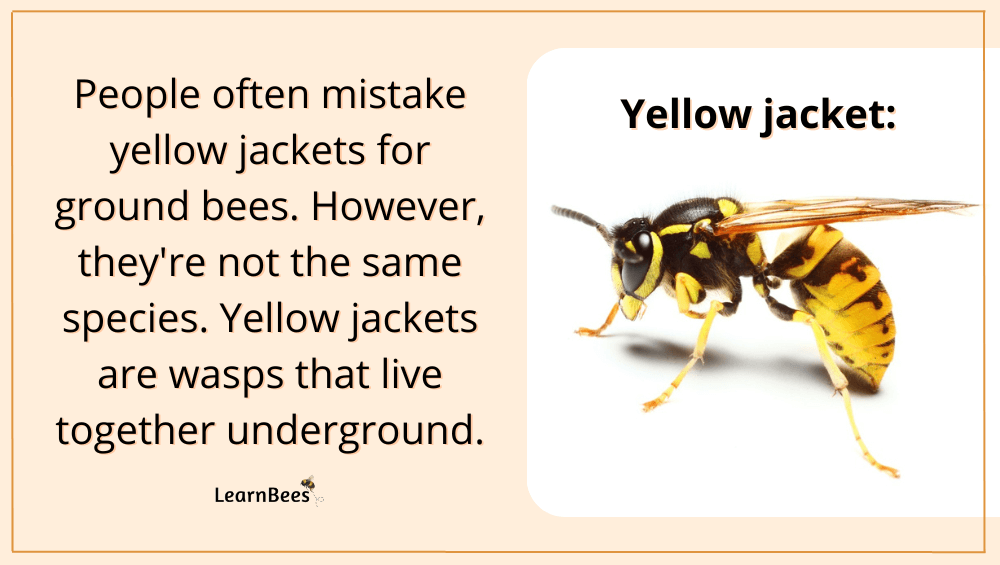
Yellow jackets are a type of wasp that nests underground. If you see a bunch of “bees” nesting together underground, then it is most likely yellow jackets.
Why?
Because yellow jackets live in social colonies with other wasps. Ground bees, however, do not. Most ground bees are solitary bees, meaning that each female bee lives alone and creates her own nest to lay her eggs in.
On the other hand?
Yellow jackets live in family units with hundreds – or even thousands – of other yellow jackets.
But let me be clear:
Like bees, yellow jackets also play an essential role in our ecosystem. That’s why we recommend leaving them alone if possible. Plus, yellow jackets will defend their nests if you get too close.
What Kind of Bees Nest in the Ground?
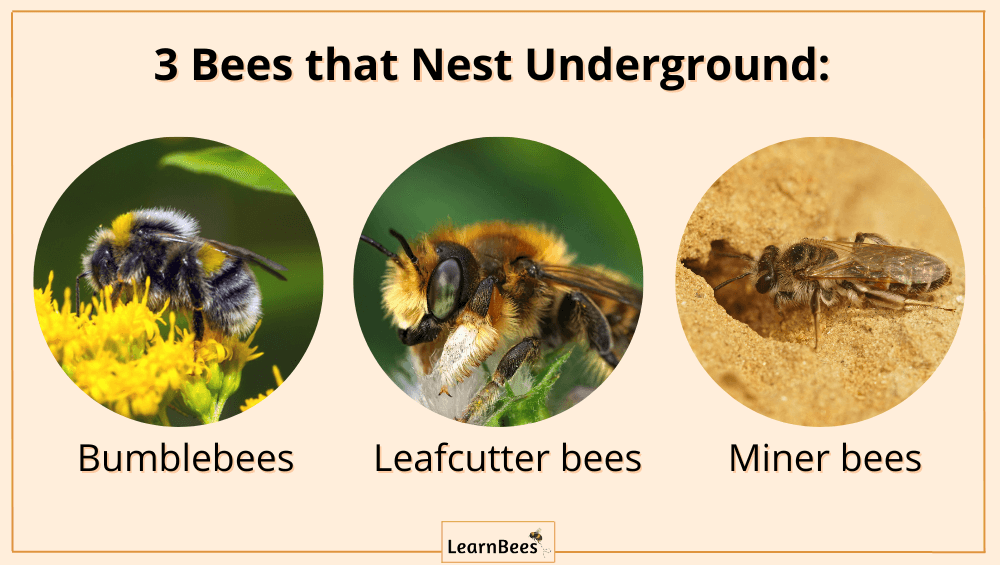
Here’s a fact that might surprise you:
Most types of bees live underground.
This includes our beloved bumblebees, leafcutter bees, and sweat bees. More specifically, research shows that an estimated 70% of bee species in North America nest underground.(3)
As mentioned, most bees that live underground are solitary creatures that live alone.
Bumblebees are the exception.
Bumblebees are a type of social bee that lives in colonies of 40-500 bumblebees. Their nests are typically built underground in empty rodent holes or other cavities.
Interestingly enough, bumblebees are one of the largest native bees we have in the United States. Queen bumblebees can measure up to one inch long – making them about the size of a quarter.
Thanks to their size and passive demeanor, bumblebees are nicknamed “gentle giants.”
If you want to help these gentle giants and other pollinators, start by planting a pollinator-friendly garden. Plants like salvia, veronica, and zinnia will go a long way in helping your local bees, butterflies, hummingbirds, and more.
How Do You Get Rid of Beehives in the Ground?
The good news is that most beehives in the ground will disappear once the weather starts cooling. From there, the rain will come and backfill their holes.
We don’t recommend using insecticides or chemicals of any kind, as that can hurt kids, pets, and other wildlife.
But what are other ways to get rid of beehives on the ground?
Here are two:
Tip 1: Irrigate your soil
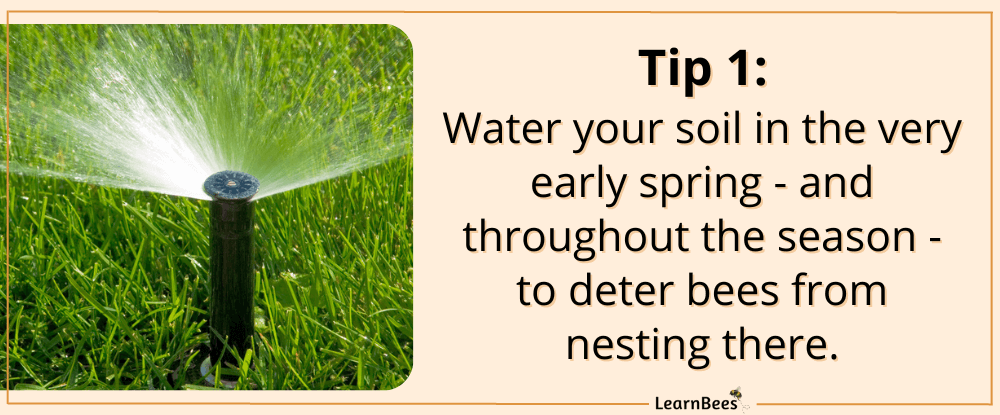
Bees dislike wet soil.
So simply watering your yard will discourage bees from nesting in the ground. The best time to start this irrigation process is in very early spring before the bees become active. This is especially important if you see bees returning to your yard year after year.
If you don’t have a sprinkler system, we recommend buying one that hooks to your garden hose. It does the work for you and makes it easier.
It’s also worth noting:
You’ll rarely find beehives on the ground with a thick, well-kept lawn. Bees prefer areas where the grass is scarce because it gives them easier access to the soil.
Tip 2: Sprinkle cinnamon over your soil
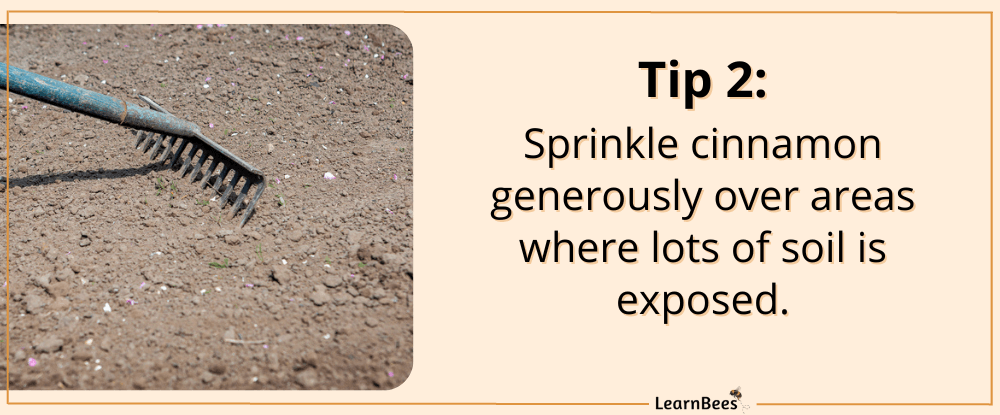
Bees may love sweet foods, but cinnamon isn’t one of them.
So sprinkling cinnamon generously over your soil is an easy trick to deter beehives on the ground. You can buy a bulk container of cinnamon to get the job done. Reapply the cinnamon if it rains or if high winds blow it away.
And don’t forget:
Use this cinnamon in very early spring before the bees start nesting. If spring is already here and the bees have already begun to nest, you can still sprinkle cinnamon to encourage the bees to move.
But that’s not ideal.
Bees are crucial pollinators that contribute to the world’s food supply. That’s why it’s best to leave the nests alone until they disappear in the late fall. You don’t want to disturb the baby bees that nest in spring, summer, and fall.
FAQs for Beehive on Ground
- Can beehives be in the ground?
- What kind of bees nest in the ground?
- How do you get rid of beehives in the ground?
- Why are bees on the ground?
- Should I get rid of ground bees?
- Can ground bees sting?
- Do ground-nesting bees make honey?
- How long do ground bees stay?
- What do you do if you find a bee in the ground?
- What ground bees are aggressive?
- How deep are ground bee nests?
- What eats beehives in the ground?
- Should I get rid of ground bees with vinegar?
Can beehives be in the ground?
Yes, in fact, most types of bees nest underground. An estimated 70% of bees in North America nest underground. Bees like leafcutter bees, miner bees, and even bumblebees build their homes beneath the surface.(3)
This provides them with insulation and protection from the natural elements, such as wind and rain. It also helps hide them from predators such as birds, skunks, and other insects.
Some bees dig their own nests in the soil. You’ll notice small holes with little piles of dirt beside them. Although most ground bees are solitary bees that live alone, you may see several bee holes in one area.
The good news is ground bees are typically docile creatures that won’t go out of their way to sting you. They’re also beneficial pollinators that contribute to food crops like apples, almonds, blueberries, and more.
—> Go back to the FAQs for beehive on ground
More to Explore:
What kind of bees nest in the ground? What kind of bees are ground bees?
There are thousands of different bee species that nest in the ground.
Keep in mind:
There are over 20,000 different bee species worldwide. Examples include mason bees, sweat bees, and bumblebees.
In North America, solitary bees are the most common ground bees. This includes species like leafcutter bees, digger bees, and mining bees.
Solitary bees live alone and don’t have queen bees or worker bees like honeybees. Each female bee builds her own nest and stocks it with food for her young.
Female ground bees can build their nests in a matter of days. They use their mandibles (jaws) to dig small holes in the ground. Once the nest is complete, the female bee will lay her eggs inside and seal the opening.
—> Go back to the FAQs for beehive on ground
More to Explore:
How do you get rid of bee hives in the ground?
If you have a bee hive in your yard and you want to get rid of it, there are a few things you can do.
Option 1: Wait it out
The first option is to simply wait for the bees to leave on their own. Most ground bee nests only last one season. The bees mate, lay eggs and die within a few months. The holes will backfill in once the rain comes and washes the soil around.
Option 2: Use cinnamon
Another option is to sprinkle cinnamon around the beehive on the ground. Try to do it in early spring before the bees become active. This will help discourage them from nesting in that area. You may need to reapply the cinnamon several times after rain or if the wind blows it away.
—> Go back to the FAQs for beehive on ground
More to Explore:
Why are bees on the ground? Why are bees hovering on the ground?
There are a few reasons why bees might be on the ground.
One reason is that they’re looking for a place to nest. As we mentioned before, many types of bees nest in the ground. So, if you see bees flying low to the ground and going in and out of small holes, they’re probably nesting there. If this is the case, you’ll notice small holes with dirt piles beside them.
Another reason bees might be on the ground is because they’re foraging for food. Bees are attracted to brightly colored flowers and plants with strong fragrances. They land on the flower to collect nectar and pollen, which they use as food. While they’re collecting this food, they also help pollinate the plant.
Lastly, bees might be on the ground because they’re dead or passing away. If you see a bee crawling around on the ground and it doesn’t look like it’s doing good, then it might be on the verge of passing away.
Most bees have short lifespans and literally work themselves to death. It’s not unusual for a bee to work 10+ daily during the warm seasons. They remain busy collecting pollen and nectar for their nests.
—> Go back to the FAQs for beehive on ground
More to Explore:
Should I get rid of ground bees?
People often ask:
Are ground bees a problem? Should I worry about ground bees?
The answer is no. You should not get rid of ground bees.
Ground bees are vital pollinators and contribute to the growth of many different crops. While they might be a nuisance if nesting in your yard, it’s best to leave them alone.
If you absolutely must get rid of them, there are a few things you can do that we mentioned earlier. You can wait for them to leave on their own or use cinnamon to discourage them.
—> Go back to the FAQs for beehive on ground
More to Explore:
- Ground Bees: Are They a Threat to Your Yard?
- Wasps vs. Honeybees: Are They Different?
- Do Bumble Bees Bite?
Can ground bees sting?
Yes, bees that nest underground can sting, but it’s unlikely. These bees are usually solitary and mind their own business. They’re not aggressive and will only sting if they feel threatened.
If you step on a bee or swat at one, it might sting you out of self-defense. This is why it’s essential to be careful to respect a bee’s space and don’t try to grab it.
—> Go back to the FAQs for beehive on ground
More to Explore:
Do ground-nesting bees make honey?
Most ground-nesting bees don’t produce honey. This is because they live alone and don’t have the extra hands necessary to produce honey.
That said, bumblebees are an exception to this.
Bumblebees are a kind of social bees that nest underground. There can be dozens to a few hundred bees per bumblebee hive. Interestingly enough, bumblebees produce small amounts of honey to sustain them when the nectar supply is short.
—> Go back to the FAQs for beehive on ground
More to Explore:
- Do Carpenter Bees Pollinate?
- How Long Do Bumble Bees Live?
- Honeybees vs. Bumblebees: How Do They Compare?
How long do ground bees stay?
Bees are active in warm seasons such as spring, summer, and fall. They’ll be around as long as the weather is good. Once it gets cold, they’ll die off or hibernate until the warm weather returns.
In short, ground bees are around for a few months out of the year. The exact time will depend on where you live and your climate.
—> Go back to the FAQs for beehive on ground
More to Explore:
- Do Queen Bees Eat Honey?
- Are Worker Bees Male or Female?
- Queen Bee Versus Worker Bees – How Do They Compare?
What do you do if you find a bee in the ground?
It’s best to leave the bee alone and allow it to go about its way.
—> Go back to the FAQs for beehive on ground
More to Explore:
- What Are Black Honeybees?
- What Do Bees Use Pollen For?
- Bees Color: 10+ Types of Colored Bees With Pictures
What ground bees are aggressive? What bees live in the ground and sting?
Most ground bees are gentle and non-aggressive. They can sting, but it’s doubtful.
—> Go back to the FAQs for beehive on ground
More to Explore:
How deep are ground bee nests?
Most beehives on the ground are between 6 to 16 inches deep.
—> Go back to the FAQs for beehive on ground
More to Explore:
What eats beehives in the ground?
Different animals are known to eat bees and their hives. These include skunks, badgers, raccoons, birds, and other insects.
—> Go back to the FAQs for beehive on ground
More to Explore:
Should I get rid of ground bees with vinegar?
No, vinegar will kill the bees. It’s best to deter them – not kill them. Deter them using cinnamon, as we mentioned earlier.
Vinegar is an acidic substance that can kill bees (and other insects) on contact. If you spray a bee with vinegar, it’ll likely die. We don’t recommend doing this because bees are vital pollinators.
